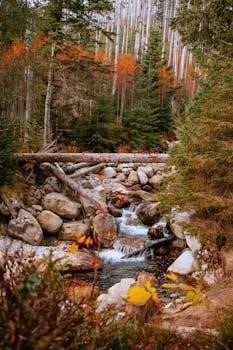Understanding Water Damage in Logs
Water damage in logs manifests in varied ways, from surface mold to deep rot. It can include swelling, discoloration, and changes in texture, indicating moisture penetration and potential structural compromise.
Identifying Types of Water Damage
Identifying water damage in logs is crucial for effective restoration. One common type is surface mold, easily recognizable by its discoloration and musty odor. This indicates moisture is present but hasn’t deeply penetrated the wood. Another type is rot, which can be either soft or hard. Soft rot makes the wood spongy, while hard rot causes it to crumble.
Swelling is another indicator, often seen when logs absorb excessive water. This can lead to structural issues if not addressed. Additionally, look for changes in the log’s texture; waterlogged wood may feel heavier and more saturated than dry wood. Shining wood is another sign of water damage, indicating the wood’s cells are filled with water; Accurate identification is the first step in preventing further damage and ensuring successful drying.
Assessing the Severity of Damage
Assessing the severity of water damage in logs requires a thorough inspection. Begin by visually examining the logs for discoloration, such as staining or mold growth. Use a moisture meter to determine the moisture content of the wood. Readings above 20% indicate a high level of moisture and potential for decay. Probe the wood with a screwdriver or awl to check for softness or crumbling, signs of rot.
Evaluate the extent of swelling or warping, as these can compromise structural integrity; Note any areas where the wood feels excessively heavy or waterlogged. Document the location and size of affected areas to track the progression of damage. Consider the age and type of wood, as some species are more susceptible to water damage. A comprehensive assessment will guide the appropriate drying and restoration strategies.

Drying Logs After Water Exposure
Drying water-exposed logs is crucial for preventing decay. Effective methods involve air drying and kiln drying, both aiming to reduce moisture content and stabilize the wood structure properly.
Air Drying Techniques for Logs
Air drying is a traditional method for reducing moisture in logs, involving natural air circulation. Proper stacking is essential; logs should be elevated off the ground using stickers—small pieces of wood—to allow airflow around each log.
Choose a location with good ventilation and protection from direct sunlight and rain to prevent uneven drying, which can lead to warping and cracking; The drying time varies depending on the log size, wood species, and local climate conditions, often taking several months to a year.
Regularly inspect the logs for signs of mold or insect infestation, addressing issues promptly to minimize damage. Air drying is a slow but energy-efficient method, resulting in logs with minimal stress and checking.
Kiln Drying Methods for Logs
Kiln drying is an accelerated method of drying logs, utilizing controlled temperature and humidity within a specialized chamber. This process allows for precise regulation of moisture extraction, reducing the risk of defects such as cracking and warping compared to air drying.
The kiln’s environment is carefully monitored to ensure even drying throughout the log, preventing surface hardening that can trap moisture inside. Different wood species require specific drying schedules, taking into account their density and moisture content to achieve optimal results.
Kiln drying significantly reduces the drying time, often taking weeks instead of months. It also eliminates pests and fungi due to the high temperatures, making the logs more stable and durable for various applications. However, it requires specialized equipment and energy consumption.

Preventing Water Damage During Drying
Preventing water damage during log drying involves careful environmental control. Managing humidity prevents excessive moisture absorption, while adequate airflow promotes even drying and deters fungal growth.
Controlling Humidity and Airflow
Effectively controlling humidity and airflow is crucial to preventing water damage during the log drying process. High humidity levels can lead to moisture reabsorption, prolonging drying times and creating an environment conducive to mold and fungal growth. Maintaining consistent airflow around the logs helps to evaporate surface moisture evenly, reducing the risk of warping and cracking.
Strategic stacking of logs with proper spacing ensures adequate air circulation. Fans can be used to enhance airflow, especially in enclosed drying spaces. Monitoring humidity levels with a hygrometer allows for adjustments to be made as needed. Dehumidifiers may be necessary in humid climates to maintain optimal drying conditions. The goal is to create a balanced environment where moisture is gradually removed without causing undue stress to the wood fibers, preventing potential defects and preserving the integrity of the logs.
Preventing Mold and Fungal Growth
Preventing mold and fungal growth during log drying is paramount to preserving wood quality. These organisms thrive in moist environments, breaking down wood fibers and causing discoloration and decay. Maintaining low humidity levels is essential, as is ensuring good air circulation to discourage spore germination.
Applying borate-based wood preservatives can effectively inhibit fungal growth without significantly affecting the wood’s natural properties. These treatments penetrate the wood and create a toxic environment for fungi. Proper storage practices, such as elevating logs off the ground and protecting them from rain, further reduce the risk. Regular inspections for signs of mold or fungal growth are crucial, allowing for early intervention. Addressing any issues promptly prevents widespread contamination, safeguarding the structural integrity and aesthetic appeal of the logs.

Defects Caused by Improper Drying
Improper drying of logs leads to various defects, diminishing their value and structural integrity; Such defects include cracking, warping, twisting, and uneven shrinkage, compromising the wood’s usability.
Checking for Cracks and Warping
After the drying process, careful inspection is crucial to identify defects like cracks and warping. Cracks appear as splits along the wood grain, resulting from uneven moisture loss. Surface checks, small cracks on the surface, are common but deeper splits compromise structural integrity. Warping, including bowing and twisting, occurs due to differential shrinkage.
To check for these defects, visually inspect each log, paying close attention to end grains and surfaces. Use a straight edge to detect bowing or twisting along the length of the log. A moisture meter can also help identify areas with high moisture content that may lead to further cracking or warping. Addressing these issues early prevents further degradation and maintains the log’s usability. Proper identification is the first step in effective restoration or repair.
The presence of these defects significantly impacts the wood’s strength and aesthetic appeal, highlighting the importance of meticulous drying practices.
Addressing Insect Damage
Insect infestations can severely compromise logs, particularly after water damage weakens the wood. Common signs include small holes, sawdust-like frass, and visible insect activity. Beetles, termites, and woodworms are frequent culprits, boring into the wood and weakening its structure.
To address insect damage, first identify the type of insect. This helps determine the appropriate treatment. Options include chemical treatments, such as borate solutions, which penetrate the wood and kill insects. For severe infestations, fumigation may be necessary. Non-chemical methods include heat treatments, which raise the wood temperature to lethal levels for insects.
Preventive measures are crucial. Keep logs dry and well-ventilated to discourage insect activity. Regularly inspect logs for signs of infestation. Prompt action minimizes damage and preserves the integrity of the wood. Addressing these issues promptly is essential for maintaining the log’s long-term durability and structural integrity.
Restoring Water-Damaged Logs
Restoring water-damaged logs involves cleaning to remove mold and debris, followed by treating with preservatives. This process aims to halt decay, strengthen the wood, and prevent future damage.
Cleaning and Treating Affected Areas
The initial step in restoring water-damaged logs is thorough cleaning. This involves removing surface contaminants like mold, mildew, and dirt. Use a soft-bristled brush and a mild cleaning solution to avoid further damage. Power washing should be approached with caution, as excessive pressure can erode the wood fibers.
Following cleaning, apply appropriate wood preservatives to prevent future decay. Borate-based solutions are effective against fungi and insects, penetrating the wood to protect it from within. Ensure the logs are adequately dried before applying any treatment to maximize absorption and effectiveness.
Consider using products designed for log homes to provide additional water repellency. Regular maintenance and inspection are also vital to address any new issues promptly. This combination of cleaning and treatment ensures the longevity and structural integrity of the logs.
Repairing Structural Damage
Addressing structural damage in water-logged logs requires a careful assessment to determine the extent of the decay. Minor damage might be repaired with epoxy fillers specifically designed for wood, providing a strong and durable bond. These fillers should be applied after the wood is thoroughly dried and cleaned.
For more significant damage, consider replacing the affected sections of the log. This involves cutting out the deteriorated area and splicing in a new piece of wood that matches the original in species and dimensions. Ensure the new section is properly treated to resist future water damage.
In severe cases, where entire logs are compromised, complete replacement is necessary. This process demands specialized skills to maintain the structural integrity of the building. Consulting with a professional log home restoration expert is highly recommended to ensure the repairs are done correctly and safely, preserving the building’s stability and value.

Resources for Further Information
Explore specialized PDF guides and publications for comprehensive insights. These resources delve into detailed drying techniques, preventative measures, and restoration methods for water-damaged logs, enhancing your knowledge.
Relevant PDF Guides and Publications
To further your understanding of drying logs after water damage, several PDF guides and publications offer invaluable information. These resources often contain detailed illustrations, step-by-step instructions, and scientific explanations that can greatly assist in effective log drying. Look for publications from forestry departments, wood science institutions, and reputable building preservation organizations.
These guides frequently cover topics such as moisture content measurement, air drying best practices, kiln drying schedules, and the prevention of common defects like cracks and warping. Additionally, you may find guides dedicated to specific wood species or types of log construction, providing tailored advice for your particular situation. Some resources may also address the safe use of chemical treatments to prevent mold and decay during the drying process.
Don’t underestimate the power of visual aids. PDF guides can provide diagrams and photographs that illustrate proper stacking techniques, airflow management, and defect identification, making it easier to apply the knowledge to real-world scenarios.

